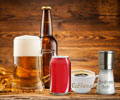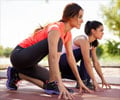Osteoporosis affects 200 million women worldwide according to a WHO Technical Report, 2007.
Osteoporosis, or ‘porous bones’, is a silent disease occurring because of reduced bone formation and increased bone resorption. Bone is a living, growing tissue made up of collagen, a protein network that gives the bone its tensile strength and framework, and calcium phosphate, a mineral that gives the bone its hard skeletal framework. More than 99 percent of the body’s calcium is present in the bones and teeth.Old bones are constantly being removed throughout a woman’s lifetime and simultaneously being replaced by new bones. This gives the body a healthy bone structure. During bone resorption, cells called osteoclasts dissolve small amounts of bone, and then, cells called osteoblasts initiate formation of new bones. Now, when the woman crosses the age of 30 years, bone resorption occurs faster than bone formation leading to ‘net bone loss. Bone loss is most rapid in the first few years of menopause and continues into the menopausal years. This is the reason why the bones in post menopausal women become weak and are more likely to break. Bones in the hip, spine and wrist are more prone to breaking at this stage.
According to the North American Menopause Society (NAMS), ‘Management strategies for osteoporosis in postmenopausal women require assessment of risk factors for bone mineral density (BMD)-defined osteoporosis and osteoporotic fracture, followed by institution of measures that focus on reducing risk factors’. They specify two approaches to management of osteoporosis – one is the lifestyle approach and the other is the pharmacological approach, only if indicated.
The lifestyle approaches to management of osteoporosis include:
1. Nutrition – Considering the fact that weak bones are the main risk factors for fractures, a healthy diet for all post menopausal women must include enough calcium and vitamin D to make the bones strong.
The National Institutes of Health (NIH) Osteoporosis and Related Bone Diseases estimated that ‘people get less than half the calcium they need’. The National Osteoporosis Foundation (NOF) recommends at least 1200mg of elemental calcium per day for postmenopausal women over 50 years of age and 800 to 1000 IU of vitamin D per day for women 50 years and older.
Caution: These products should be separated from medications such as iron, tetracyclines and fluoroquinolones since they can interfere with absorption.
The NOF also recommends incorporating vegetables and fruits into daily diet for women with osteoporosis.
2. Exercise plan - Exercising is very important for women with osteoporosis. However, women need to consult a doctor and discuss an exercise regimen with the fitness trainer that will not aggravate the osteoporosis condition. The NOF suggests a minimum of 30 minutes of either aerobic or weight bearing and muscle strengthening exercise three times per week for post menopausal women. The National Institutes of Health (NIH) recommends exercising in the form of walking, hiking, jogging, climbing stairs, lifting weights, playing tennis and dancing to increase bone strength in women with osteoporosis.
3. Smoking cessation and reducing alcohol consumption - Women with osteoporosis need to quit smoking and reduce excessive drinking. Smoking is bad not only for the heart and lungs but for the bones as well. It has been established that people with excessive alcohol consumption are more prone to bone loss and broken bones because of risk of falling and poor eating habits.
4. Fall prevention - The best way to avoid fractures is to avoid a fall. Global data reveals that an osteoporotic fracture occurs every 3 seconds and one in three women over 50 years of age experience osteoporotic fractures. To minimize the risk of falls, the NIH suggests –
• Regularly monitoring vision and hearing.
• Clearing indoor and outdoor walkways.
• Carefully using the walkways for wheelchairs and bicycles because the incline (up or down) may lead to fall.
• Paying attention to the floor in public buildings, especially where the floors are slippery (highly polished marble or tile) or wet.
• Wearing warm boots with rubber soles outdoors for added traction when it is cold or snowy; and wearing supportive shoes without high heels even at home.
• Using bright lighting at home and ensuring that stairs have plenty of light and there are handrails on both sides.
• Using a rubber bath mat in the shower or tub so the chance of slipping is reduced.
‘The bottom line is to preserve the bone mass and density and a person has to decrease the risk of broken bones (osteoporotic fractures) and disability’, say orthopedists. However, in case the fall cannot be prevented, the American Society of Orthopedic Professionals recommends the following steps to lessen the chances of breaking a bone if a fall occurs. In their words -
• ‘Try not to fall sideways or straight down because a hip fracture is more likely to occur than if the fall is in other directions. If possible, try to fall forward or to land on the buttocks.
• Even though a broken arm or wrist may result, try to land on the hands because a broken arm has fewer complications than a broken hip.
• Break a fall by grabbing onto counters or other surfaces around.
• Walk carefully, especially on hard or slippery surfaces.
• When possible, wear protective clothing for padding or wear hip (trochanteric) pads. Talk to a doctor about hip padding.’
Certain medications such as sedatives, anticholinergics, benzodiazepines, tricyclic anti-depressants and anti-hypertensives that cause hypotension can affect balance. So, it is best to limit the use of such medications as far as possible.
The pharmacologic options approved by the US Food and Drug Administration (FDA) for women with osteoporosis include bisphosphonates, calcitonin, hormone therapy, raloxifene, and parathyroid hormone (PTH 1-34).
It is very important to get professional counseling on safe use of medications for osteoporosis. Medical adherence and monitoring of BMD (bone-mass density) is critical to reduce the risk of fracture and to monitor the progression of osteoporosis.
References:
1. Bones and osteoporosis
http://labtestsonline.org/understanding/analytes/
bone-markers/tab/glance
2. Management of osteoporosis
http://www.menopause.org/psosteo10.pdf
3. Management of osteoporosis
http://www.guideline.gov/content.aspx?id=15500
4. Lifestyle approach
http://www.uspharmacist.com/content/d/
feature/c/30060/
5. Exercise
http://www.niams.nih.gov/Health_Info/Bone/
osteoporosis/osteoporosis_ff.pdf
6. Fractures data
http://www.iofbonehealth.org/facts-and-statistics.html
7. Fall prevention
http://www.asop.org/fall-prevention-and-osteoporosis/
Source-Medindia













